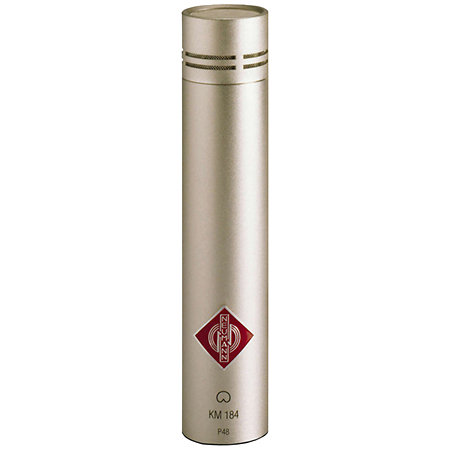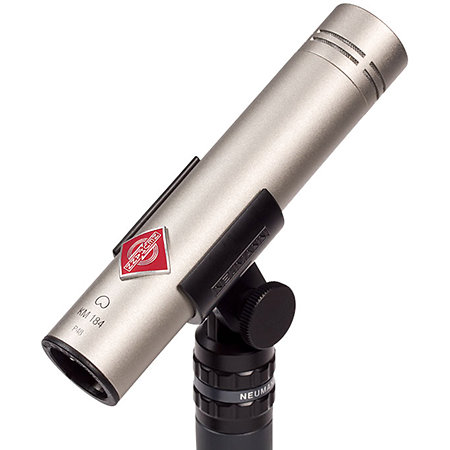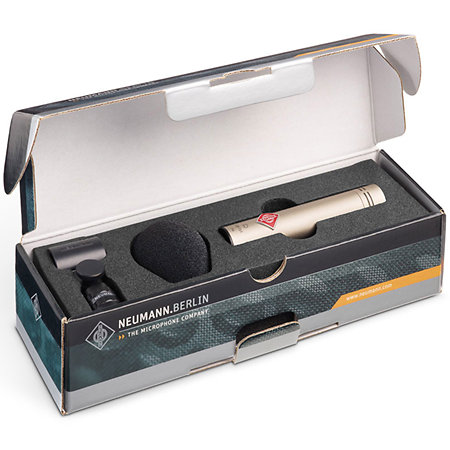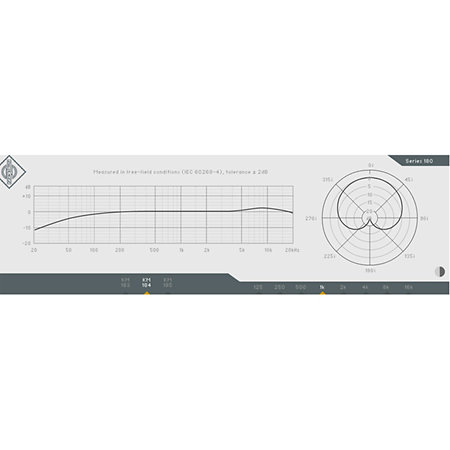Neumann - KM 184
624,17 €
excl VAT
with eco participation: 0,02 €
In Stock
Usually shipped within 3 days
+infos
Static Microphone
Small diaphragm microphone, electrostatic, cardioid, XLR-3F, 48 V phantom power, nickel, supplied with WNS100 and SG21.
ARTICLE N° 32705
Specifications
-
Neumann KM 184
-
Cardioid studio instrument microphone
-
Frequency response 20 Hz to 20 kHz
-
Pressure/pressure gradient transducer
-
Sensitivity at 1 kHz, 1 kOhm load 12/15/10 mV/Pa*
-
Nominal output impedance 50 Ohms
-
Recommended load impedance 1000 Ohms
-
Input noise level, according to CCIR 468-3 24/22/24 dB SPL*
-
Input noise level, according to DIN/IEC 651 13/13/15 dB SPL (A)*
-
Signal-to-noise ratio, according to CCIR 468-3 70/72/70 dB*
-
Signal-to-noise ratio, according to DIN/IEC 651 81/81/79 dB*
-
Maximum SPL level, for THD = 0.5 % 140/138/142 dB*
-
Maximum output level 10 dBu
-
Phantom power 48 V ± 4 V
-
Current consumption 3.2 mA
-
Output connector XLR 3M
-
Weight approx.
-
80 g
-
Diameter 22 mm
-
Length 107 mm
-
Color: black
Presentation
Studio cardioid instrument microphone.
A standard in studios around the world. A good choice for all users looking for a high-quality miniature microphone.
A standard in studios around the world. A good choice for all users looking for a high-quality miniature microphone.
Information
Capsule type
Capacitor
Application
Ambiance, Piano, Acoustic guitar, Strings instruments, Video / broadcast
Directivity
Cardioid
Shockmount included
No
Microphone clip
Yes
Complete set
Yes
Power supply
Via +48 V phantom power supply
Color
Nickel
Connectors
XLR male 3 pins
Frequency response, upper limit
20 kHz
Frequency response, low limit
20 Hz
Packaging
Single unit
To go further...
The 180 series consists of three compact microphones, whose polar patterns meet the requirements of the most common studio applications.
Thanks to its optimized mechanical design and the deliberate rejection of the modular aspect, which is superfluous in many cases, the 180 series is predestined for productions on tight budgets and home studios.
The KM 183 (omnidirectional) and the KM 185 (hypercardioid) are based on the cardioid microphone KM 184, whose tremendous success quickly made it a standard in studios all over the world.
All microphones in the 180 series are available in matte black or nickel finish.
Applications
Their tapered shape and the pickup characteristics described below make the microphones in the 180 series versatile tools, suitable for a wide variety of tasks, particularly in the radio and television sectors.
Acoustic characteristics
The KM 183 and KM 184 are the successors of the legendary KM 83 and KM 84 models, which have been used successfully worldwide since the 1970s.
The KM 185, with a hypercardioid directivity, completes the range.
The KM 183 is a pressure transducer whose response curve has a hump of approximately 7 dB at 10 kHz in free field; in the diffuse field, the response curve is flat.
The KM 184 and KM 185 pressure gradient transducers have a very linear response curve not only for on-axis incidence (0°), but also for lateral incidence (off-axis).
During typical use, no sound coloration is detectable, even at a very wide pickup angle.
Although the KM 184 has the same capsule as the KM 84, the two microphones have a slight difference in frequency response at an incidence angle of 0°.
The KM 184 has a slight emphasis above 9 kHz - a feature introduced, with great success, on the KM 140.
Compared to the KM 84, which is neutral in this frequency range, the result is a more lively tonal balance with greater freshness.
This difference is achieved by a slight modification of the rear openings of the capsule, and not by playing on internal resonances.
The KM 185, with its hypercardioid response curve, ensures an attenuation of approximately 10 dB of sounds coming from the rear or sides, the minimum sensitivity corresponding to an incidence angle of 120°.
Electrical characteristics
The microphones of the 180 series have the same transformerless output circuit as the KM 100 system, which gives them excellent technical characteristics:
Compared to the KM 84 model, the dynamic range of the KM 184 is 24 dB higher, thanks in part to a self-noise level reduced to only 22 dB (CCIR) and a higher maximum acceptable sound pressure level (up to 138 dB SPL).
The microphones operate without problems, even if the input of the recorder is unbalanced (as is the case with some portable DATs, for example).
As with all Neumann microphones, the output of the KM 18x is balanced, and the microphones are powered by phantom voltage (48 Volts).
Economy
The microphones of the 180 series are a good choice for all users who are looking for a high-quality miniature microphone, but who do not necessarily need a complex modular system like the KM 100, which is still part of the Neumann product family.
The mechanical construction is simplified: for example, on the KM 18x it is not possible to separate the capsule and the output stage.
As a result, this microphone family is an economical alternative, while still ensuring the electro-acoustic characteristics that users expect from Neumann microphones.
Thanks to its optimized mechanical design and the deliberate rejection of the modular aspect, which is superfluous in many cases, the 180 series is predestined for productions on tight budgets and home studios.
The KM 183 (omnidirectional) and the KM 185 (hypercardioid) are based on the cardioid microphone KM 184, whose tremendous success quickly made it a standard in studios all over the world.
All microphones in the 180 series are available in matte black or nickel finish.
Applications
Their tapered shape and the pickup characteristics described below make the microphones in the 180 series versatile tools, suitable for a wide variety of tasks, particularly in the radio and television sectors.
Acoustic characteristics
The KM 183 and KM 184 are the successors of the legendary KM 83 and KM 84 models, which have been used successfully worldwide since the 1970s.
The KM 185, with a hypercardioid directivity, completes the range.
The KM 183 is a pressure transducer whose response curve has a hump of approximately 7 dB at 10 kHz in free field; in the diffuse field, the response curve is flat.
The KM 184 and KM 185 pressure gradient transducers have a very linear response curve not only for on-axis incidence (0°), but also for lateral incidence (off-axis).
During typical use, no sound coloration is detectable, even at a very wide pickup angle.
Although the KM 184 has the same capsule as the KM 84, the two microphones have a slight difference in frequency response at an incidence angle of 0°.
The KM 184 has a slight emphasis above 9 kHz - a feature introduced, with great success, on the KM 140.
Compared to the KM 84, which is neutral in this frequency range, the result is a more lively tonal balance with greater freshness.
This difference is achieved by a slight modification of the rear openings of the capsule, and not by playing on internal resonances.
The KM 185, with its hypercardioid response curve, ensures an attenuation of approximately 10 dB of sounds coming from the rear or sides, the minimum sensitivity corresponding to an incidence angle of 120°.
Electrical characteristics
The microphones of the 180 series have the same transformerless output circuit as the KM 100 system, which gives them excellent technical characteristics:
Compared to the KM 84 model, the dynamic range of the KM 184 is 24 dB higher, thanks in part to a self-noise level reduced to only 22 dB (CCIR) and a higher maximum acceptable sound pressure level (up to 138 dB SPL).
The microphones operate without problems, even if the input of the recorder is unbalanced (as is the case with some portable DATs, for example).
As with all Neumann microphones, the output of the KM 18x is balanced, and the microphones are powered by phantom voltage (48 Volts).
Economy
The microphones of the 180 series are a good choice for all users who are looking for a high-quality miniature microphone, but who do not necessarily need a complex modular system like the KM 100, which is still part of the Neumann product family.
The mechanical construction is simplified: for example, on the KM 18x it is not possible to separate the capsule and the output stage.
As a result, this microphone family is an economical alternative, while still ensuring the electro-acoustic characteristics that users expect from Neumann microphones.
You may also like
Neumann - KM 184
Neumann - KM 184
624,17 €
excl VAT
with eco participation: 0,02 €
In Stock
Usually shipped within 3 days
+infos
Spotlight on
A legendary brand for decades, present in all the major recording studios, Neumann is a guarantee of high quality and professionalism. The Beatles, Natalie Cole, Celine Dion, Bryan Adams and Beyoncé... all use this exceptional brand with the famous U87, and the TLM49 at the top of the list. In home studio, the TLM103 and TLM102 condenser microphones are the most popular. For studio sound on stage opt for the KMS105. In recent years, Neumann has also offered the high-end KH80, KH120 and KH310 monitors.















